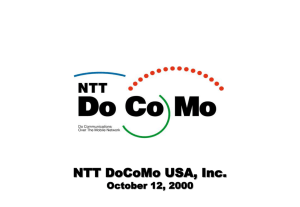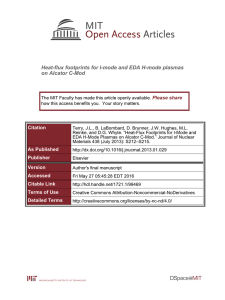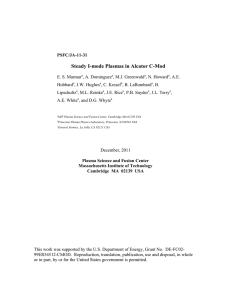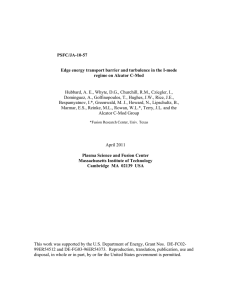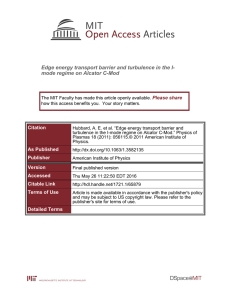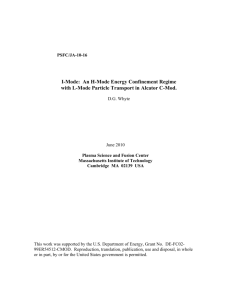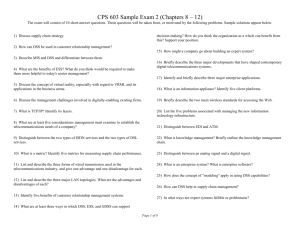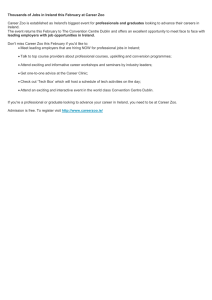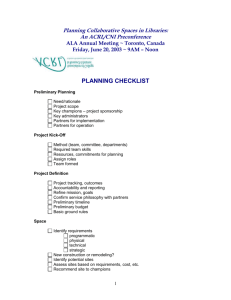MARKETING i-MODE
advertisement
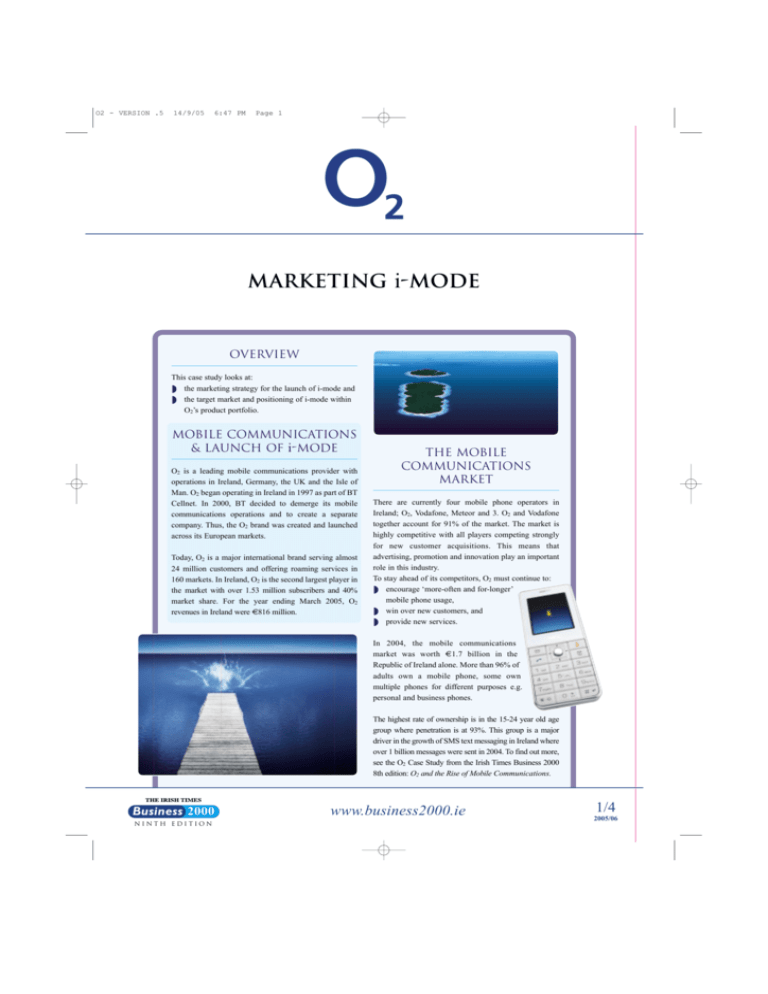
O2 - VERSION .5 14/9/05 6:47 PM Page 1 MARKETING i-mode Overview This case study looks at: ◗ the marketing strategy for the launch of i-mode and ◗ the target market and positioning of i-mode within O2’s product portfolio. MOBILE COMMUNicATIONS & LAUNCH OF i-mode O2 is a leading mobile communications provider with operations in Ireland, Germany, the UK and the Isle of Man. O2 began operating in Ireland in 1997 as part of BT Cellnet. In 2000, BT decided to demerge its mobile communications operations and to create a separate company. Thus, the O2 brand was created and launched across its European markets. Today, O2 is a major international brand serving almost 24 million customers and offering roaming services in 160 markets. In Ireland, O2 is the second largest player in the market with over 1.53 million subscribers and 40% market share. For the year ending March 2005, O2 revenues in Ireland were €816 million. THE MOBILE COMMUNICATIONS MARKET There are currently four mobile phone operators in Ireland; O2, Vodafone, Meteor and 3. O2 and Vodafone together account for 91% of the market. The market is highly competitive with all players competing strongly for new customer acquisitions. This means that advertising, promotion and innovation play an important role in this industry. To stay ahead of its competitors, O2 must continue to: ◗ encourage ‘more-often and for-longer’ mobile phone usage, ◗ win over new customers, and ◗ provide new services. In 2004, the mobile communications market was worth €1.7 billion in the Republic of Ireland alone. More than 96% of adults own a mobile phone, some own multiple phones for different purposes e.g. personal and business phones. The highest rate of ownership is in the 15-24 year old age group where penetration is at 93%. This group is a major driver in the growth of SMS text messaging in Ireland where over 1 billion messages were sent in 2004. To find out more, see the O2 Case Study from the Irish Times Business 2000 8th edition: O2 and the Rise of Mobile Communications. Business 2000 ninth edition www.business2000.ie 1/4 2005/06 O2 - VERSION .5 14/9/05 6:47 PM Page 2 THE O2 PRODUCT PORTFOLIO O2’s product portfolio comprises of three main categories: ◗ Voice Services: voice calls, roaming services, O2 Assistant, groupconferencing, voicemail. ◗ Data Services: (SMS) text, (MMS) picture messaging, video messaging, O2 Active, email, O2 Data Cards. ◗ Online Services: O2.ie mail, My Account, Webtext, online shopping. As phone ownership and usage is so high, the communications market is considered to be at the mature stage of the product life cycle. Future growth will come from non-voice services such as SMS and picture messaging, Internet downloads and web communication. This formed the foundation for O2’s planned introduction to i-mode, which enables their customers to access selected Internet sites faster and more easily than before. Business users The number of business users is smaller but among this segment mobile phone usage is much higher. In 2004, this segment accounted for almost €635 million in Ireland. The majority of these users are bill-pay customers. Within this segment there are two main groupings: ◗ SMEs: (Small/medium sized enterprises). These are companies which have between 1-199 employees. These include start-ups and young companies still growing. These businesses are more budget-conscious and an increasing number are availing of pre-paid deals. ◗ Corporate: These are larger companies employing over 200 people. These organisations have very specific requirements and have greater demand for non-voice products. They are the major users of the Data Card developed by O2 which provides always-on Internet and email access. TARGET MARKETING What is i-mode? i-mode is a service which allows customers fast access to sites on the Internet that have been optimised for their mobile phone at the push of a button. i-mode technology is easy to use and able to host a huge range of top Internet sites. i-mode was developed by NTT DoCoMo in Japan in 1999 and is now used by over 43 million subscribers there. In October 2004, O2 announced they had formed a strategic alliance with NTT DoCoMo and would launch i-mode on their markets in late 2005. MARKET SEGMENTATION The mobile communications market has two main segments: personal users and business users. These users also fall into further important classifications: pre-paid and bill-pay. Pre-paid users pay for their calls in advance using cards and top-up options. Currently, this is the largest segment accounting for over 74% of the Irish market. 6% of customers who bill-pay are personal users, so business customers mainly use this method of payment. Personal users ◗ Young Professionals: They tend to use their mobile instead of a landline, living in rented accommodation or first homes. Those who use mobiles for texting, off-peak calls and emergencies are generally quite budget-conscious and may fall within lower income groups. ◗ Second/Third Level Students: This group is comfortable with technology and use their phones for downloading video clips, games, ringtones and picture messaging. ◗ Teenagers: This group of technically savvy users is interested in games, ringtones and downloads being an important part of the product offering. 2/4 2005/06 O2 Marketing i-MODE Clearly, all of these groups have different requirements and O2 targets them in different ways. Target marketing is the process of dividing the market into identifiable segments (or groups) based on behaviour or other shared characteristics. Businesses must then select which segments they can serve best and most competitively. These then become the target market(s) for the company. TARGET MARKETING STRATEGIES Companies can target markets in four main ways: ◗ Undifferentiated marketing: The ‘mass market’ approach where one marketing mix is developed for the whole market e.g. ESB, as the same service is provided for everyone. ◗ Differentiated marketing: A separate marketing mix for each target market e.g. O2 BlackBerry for business customers and phones with parental security for children. Concentrated marketing: One segment only and the business ◗ specialises in serving that one target market e.g. Ferrari only target high income consumers. ◗ Focused marketing: One customer segment. This is primarily the case with business-to-business (B2B) marketing e.g. developing specialised software systems for a large bank. i-mode Market Research Market research carried out by O2 showed the primary target market for i-mode to be 25-34 year old male and female young professionals with a high disposable income living in urban areas. This group uses the Internet as part of their daily lives. They would typically access sites like airlines, music, banking, news, entertainment, classifieds and health websites. Business 2000 ninth edition O2 - VERSION .5 14/9/05 6:47 PM Page 3 DIFFERENTIATION Differentiation gives a product/service a unique advantage setting it apart from competitors’ products. This advantage is recognised by consumers and they are willing to pay a higher price for it. As the mobile communications market moves into maturity, companies must find new ways to stay ahead of the competition. In mobile communications this is done largely through marketing and innovation. Companies develop differential advantage by improving the design of handsets and/or by developing new technologies to create new benefits for customers. O2 can differentiate their products and services according to which benefit they are satisfying. How is i-mode different? i-mode runs on a different technology called chtml (a subset of html) which makes it quicker to access and more user friendly. The main customer benefits of i-mode are: ◗ Fast access to a range of services through an i-button on the phone. ◗ Easy for content providers to create an i-mode site. ◗ More services available. Already there are almost 90,000 i-mode sites worldwide, including news, weather, search engines, banking, cinema listings and music ring tone downloads. ◗ i-mode is designed to be "walk-out working", i.e. the phone comes fully operational and customers have no further hassle with set-up. ◗ Pricing is clear and transparent so customers know exactly how much they are spending. i-mode provides customers with all the benefits of the Internet on their mobile phone. It is the first mobile Internet communications system to do this, therefore the challenge for O2 is: How to inform the market of the benefits of i-mode? To achieve this, the positioning and the launch strategy of the new service is crucial. POSITIONING Positioning relates to the consumer’s perception and image of a product/service. It involves developing a unique position for the product/service in the mind of the consumer. Positioning may be based on the features, benefits, occasion of use or even the type of user for the particular product/service. It is important that companies select one major basis on which to position a product/service so that consumers develop the desired image of and attitude towards it. Positioning i-mode To understand how consumers were likely to perceive i-mode, O2 carried out market research. The findings helped them to understand the key benefits for consumers and position its marketing strategy. Some key issues were: ◗ Communication: O2 must show how significantly different i-mode is to other services. Customers will need to be educated in this. ◗ Access: Customers must understand how easy it is to use i-mode. ◗ Handsets: Design of handsets is crucial to product appeal, so i-mode will need to be launched with exciting new handsets. ◗ Pricing: Customers are concerned they may run up bills without knowing, so this pricing must be communicated clearly. ◗ Services: Research showed O2 which services customers would prefer to have available. This is important, not only for the launch, but also helps determine which companies should be approached to become i-mode partners. Given the target market already identified, it became clear that i-mode should be positioned as pioneering (new and exciting), status (lifestyle and "cool" factor), and fun. Business 2000 ninth edition O2 Marketing i-MODE 3/4 2005/06 O2 - VERSION .5 14/9/05 6:47 PM Page 4 LAUNCH STRATEGY ACTIVITy Your class is competing in the Young Scientist of the Year competition and your team has developed a software programme called ‘Homework Helper’. You have become aware of O2’s new i-mode service and believe this to be an exciting vehicle for your programme. However, you need to convince O2 to host the site. The class is divided into teams of 4 – 6 persons. Each team competes for the prize of becoming an i-mode partner site. When all tasks have been completed each team will give a formal presentation to ‘pitch’ the product to O2 – the business teacher and one member from each of the other teams will represent O2 at the presentation. Marketing Mix The campaign to launch i-mode carried the message: i-mode is exciting, fun, easy-to-use and allows customers to access any Internet service they require at the push of one button on their mobile phone. This message was carried to its two main targets: consumers and retailers. It was important also for O2 to inform retailers of the i-mode launch in advance to create excitement about the potential business i-mode would generate for them. Retailers were invited to launch events, received training on i-mode and were given exciting interactive POS (point-of-sale) displays and handsets. The comprehensive campaign included TV advertising, print ads (newspaper and magazines) and outdoor advertising such as billboards, bus stops, as well as on-street activity. Online marketing was important too, including banner ads, interactive games etc. on partner sites like Google (Ireland). CONCLUSION i-mode is an exciting new method of mobile internet technology, giving customers fast and easy access to a wide variety of services and sites, of both global and local interest. For O2 to successfully introduce i-mode into the Irish market they had to research the market to correctly identify their primary target market and then develop a positioning strategy which ensured consumers developed the desired image of the service. Finally, the service had to be launched successfully, and this was carried out by means of integrated marketing communications to ensure that all targeted consumers were reached, and that one message was consistently delivered. 4/4 2005/06 O2 Marketing i-MODE 1. Segment the market for your service. 2. Decide on a target marketing strategy. Define the segment(s) chosen, justify the selection and give reasons for your strategy. 3. Develop a positioning strategy for your target market. 4. Develop a communications/launch strategy for the product. 5. Prepare a presentation to pitch the product to O2. All team members must participate in the presentation. After each presentation there will be a Q&A session where O2 can question the strategy. After all presentations O2 will make a decision Find out more For more information on O2: ◗ Click on the website www.O2.ie While every effort has been made to ensure the accuracy of information contained in this case study, no liability shall attach to either The Irish Times Ltd. or Woodgrange Technologies Ltd. for any errors or omissions in this case study. The launch of i-mode began in October 2005. The campaign was designed to create interest, anticipation and curiosity in the target market. Crucially, the campaign was designed to be fully integrated - where all communication channels sent the same message to consumers. The objectives of this campaign were: ◗ To create awareness of the i-mode brand. ◗ Communicate the benefits and educate the consumer on i-mode services. ◗ Demonstrate the key i-mode services. ◗ Motivate consumers to go to the store to experience – and then purchase – i-mode. Business 2000 ninth edition
